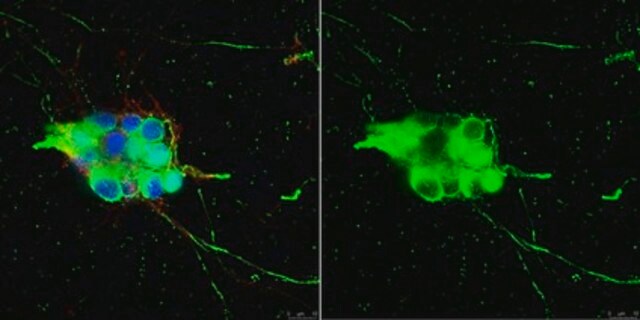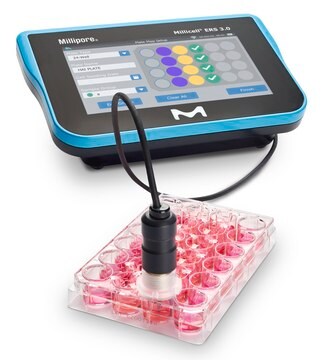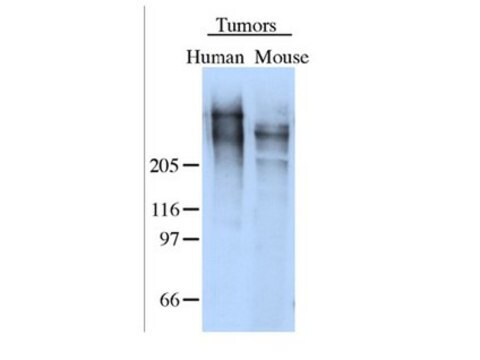ABN1655
Anti-p75NTR Antibody, ICD
serum, from rabbit
Synonym(e):
Tumor necrosis factor receptor superfamily member 16, CD271, Gp80-LNGFR, Low-affinity nerve growth factor receptor, Low affinity neurotrophin receptor p75NTR, NGF receptor, p75 ICD
About This Item
Empfohlene Produkte
Biologische Quelle
rabbit
Qualitätsniveau
Antikörperform
serum
Antikörper-Produkttyp
primary antibodies
Klon
polyclonal
Speziesreaktivität
chicken, mouse, human, rat
Methode(n)
immunocytochemistry: suitable
immunofluorescence: suitable
immunoprecipitation (IP): suitable
western blot: suitable
NCBI-Hinterlegungsnummer
UniProt-Hinterlegungsnummer
Versandbedingung
ambient
Posttranslationale Modifikation Target
unmodified
Angaben zum Gen
rat ... Ngfr(24596)
Allgemeine Beschreibung
Spezifität
Immunogen
Anwendung
Neurowissenschaft
Immunofluorescence Analysis: A representative lot localized p75ICD immunoreactivity in cryosections from various stages of chick embryos fixed with 4% paraformaldehyde and permeabilized by 0.1% Triton X-100 (López-Sánchez, N., et al. (2007). Physiol. Genomics. 30(2):156-171).
Immunoprecipitation Analysis: A representative lot co-immunoprecipitated NRIF with p75 from rat sympathetic neurons. Co-immunoprecipitation of exogenously expressed NRIF and p75 by this antiserum was also seen using 293 transfectant. Increased CTF and ICD fragments were immunoprecipitated from PMA-treated 293 transfectants and from BDNF-treated neurons (in the presence of proteasome inhibitor). Co-treatment with gamma-secretase inhibitor abolished ICD, but not CTF cleavage in PMA- and BDNF-treated cells (Kenchappa, R.S., et al. (2006). Neuron. 50(2):219-232).
Western Blotting Analysis: A representative lot detected p75 in rat sympathetic neurons. Increased ~30 kDa CTF and ~25 kDa ICD fragments were detected from BDNF- or PMA-, but not NGF-, treated neurons (in the presence of proteasome inhibitor). Co-treatment with gamma-secretase inhibitor abolished ICD, but not CTF cleavage in BDNF-treated cells (Kenchappa, R.S., et al. (2006). Neuron. 50(2):219-232).
Western Blotting Analysis: A representative lot detected p75 in superior cervical ganglia (SCG) whole tissue lysate from P4 and P24 postnatal rats. CTF and ICD fragments were detected only in P4, but not P24 SCG lysate (Kenchappa, R.S., et al. (2006). Neuron. 50(2):219-232).
Qualität
Western Blotting Analysis: A 1:5,000 dilution of this antiserum detected the ~25 kDa p75NTR (neurotrophin receptor) ICD fragment in 10 µg of mouse retina tissue lysate.
Zielbeschreibung
Physikalische Form
Lagerung und Haltbarkeit
Handling Recommendations: Upon receipt and prior to removing the cap, centrifuge the vial and gently mix the solution. Aliquot into microcentrifuge tubes and store at -20°C. Avoid repeated freeze/thaw cycles, which may damage IgG and affect product performance.
Sonstige Hinweise
Haftungsausschluss
Sie haben nicht das passende Produkt gefunden?
Probieren Sie unser Produkt-Auswahlhilfe. aus.
Lagerklassenschlüssel
12 - Non Combustible Liquids
WGK
WGK 1
Analysenzertifikate (COA)
Suchen Sie nach Analysenzertifikate (COA), indem Sie die Lot-/Chargennummer des Produkts eingeben. Lot- und Chargennummern sind auf dem Produktetikett hinter den Wörtern ‘Lot’ oder ‘Batch’ (Lot oder Charge) zu finden.
Besitzen Sie dieses Produkt bereits?
In der Dokumentenbibliothek finden Sie die Dokumentation zu den Produkten, die Sie kürzlich erworben haben.
Unser Team von Wissenschaftlern verfügt über Erfahrung in allen Forschungsbereichen einschließlich Life Science, Materialwissenschaften, chemischer Synthese, Chromatographie, Analytik und vielen mehr..
Setzen Sie sich mit dem technischen Dienst in Verbindung.







